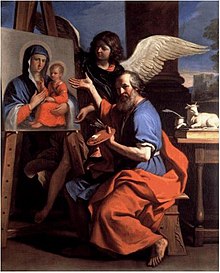Academy of Saint Luke

St. Luke Displaying a Painting of the Virgin by Guercino
|
|
| Named after | St. Luke |
|---|---|
| Formation | 1577 |
| Founded at | Rome |
| Type | Association of artists |
| Purpose | Elevating the work of "artists" |
| Leader | Federico Zuccari |
| Secessions | Accademia Nazionale di San Luca |
|
Formerly called
|
Compagnia di San Luca |
The Accademia di San Luca, (the "Academy of Saint Luke") was founded in 1577 as an association of artists in Rome (under the directorship of Federico Zuccari from 1593), with the purpose of elevating the work of "artists", which included painters, sculptors and architects, above that of mere craftsmen. Other founders included Girolamo Muziano and Pietro Olivieri. The Academy was named after Saint Luke the evangelist who, legend has it, made a portrait of the Virgin Mary, and thus became the patron saint of painters' guilds.
From the late 16th century until it moved to its present location at the Palazzo Carpegna, it was based in an urban block by the Roman Forum and although these buildings no longer survive, the Academy church of Santi Luca e Martina, does. Designed by the Baroque architect, Pietro da Cortona, its main facade overlooks the Forum.
The Academy's predecessor was the Compagnia di San Luca, a guild of painters and miniaturists, which had its statutes and privileges renewed at the much earlier date of 17 December 1478 by Pope Sixtus IV. Included among its founding members, was the famous painter Melozzo da Forlì, as he was the pictor papalis in that period.
In 1605, Pope Paul V granted the Academy the right to pardon a condemned man on the feast of St. Luke. In the 1620s, Urban VIII extended its rights to decide who was considered an artist in Rome and it came under the patronage of his nephew, Cardinal Francesco Barberini. In 1633, Urban VIII gave it the right to tax all artists as well as art-dealers, and monopolize all public commissions. These latter measures raised strong opposition and apparently were poorly enforced.
Over the early years, the papal authorities exerted a large degree of control over the leadership of the institution. Some modern critics have stated "with the ostensible purpose of giving artists a higher education and the real one of asserting the Church's control over art,".
...
Wikipedia
